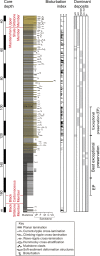The Chengjiang Biota inhabited a deltaic environment
- PMID: 35322027
- PMCID: PMC8943010
- DOI: 10.1038/s41467-022-29246-z
The Chengjiang Biota inhabited a deltaic environment
Abstract
The Chengjiang Biota is the earliest Phanerozoic soft-bodied fossil assemblage offering the most complete snapshot of Earth's initial diversification, the Cambrian Explosion. Although palaeobiologic aspects of this biota are well understood, the precise sedimentary environment inhabited by this biota remains debated. Herein, we examine a non-weathered core from the Yu'anshan Formation including the interval preserving the Chengjiang Biota. Our data indicate that the succession was deposited as part of a delta influenced by storm floods (i.e., produced by upstream river floods resulting from ocean storms). Most Chengjiang animals lived in an oxygen and nutrient-rich delta front environment in which unstable salinity and high sedimentation rates were the main stressors. This unexpected finding allows for sophisticated ecological comparisons with other Burgess Shale-type deposits and emphasizes that the long-held view of Burgess Shale-type faunas as snapshots of stable distal shelf and slope communities needs to be revised based on recent sedimentologic advances.
© 2022. The Author(s).
Conflict of interest statement
The authors declare no competing interests.
Figures



References
-
- Hou, X., et al. The Cambrian fossils of Chengjiang, China: the flowering of early animal life. 316p., (Wiley Blackwell, Second Edition, 2017).
-
- Zhao F, Zhu M, Hu S. Community structure and composition of the Cambrian Chengjiang biota. Sci. China Earth Sci. 2010;53:1784–1799.
-
- Yang X, et al. A juvenile-rich palaeocommunity of the lower Cambrian Chengjiang biota sheds light on palaeo-boom or palaeo-bust environments. Nat. Ecol. Evol. 2021;5:1082–1090. - PubMed
-
- Ma X, Hou X, Edgecombe GD, Strausfeld NJ. Complex brain and optic lobes in an early Cambrian arthropod. Nature. 2012;490:258–261. - PubMed
-
- Saleh F, et al. Taphonomic bias in exceptionally preserved biotas. Earth Planet. Sci. Lett. 2020;529:115873.
Publication types
MeSH terms
Substances
LinkOut - more resources
Full Text Sources

